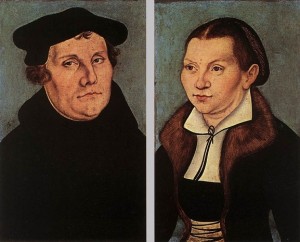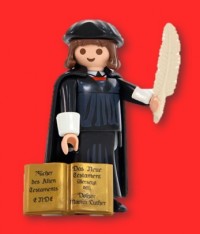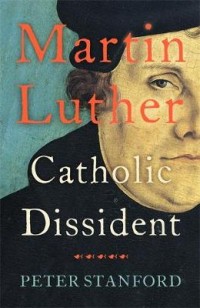Martin Luther: Catholic Dissident - Review
Aaron Lewendon - Eden Bibles & Bible Study Specialist

Hidden amongst the bust-filled marble hallways of the Uffizi Art Gallery in Florence - home to resplendent Madonnas, Botticelli's iconic The Birth of Venus, and countless other spectacular artworks - is a portrait striking by its absolute simplicity. Smaller than a sheet of A4 paper, and held in a simple frame. It’s background is of a plain teal that is not quite natural, not quite artificial. The austere faces of a man and a women look into a middle distance with dispassioned eyes.

Compared with the grandeur of the immense artworks and architecture in the Uffizi, this small portrait almost offends by its refusal to amaze. Stumbling across it, I struggled to reason as to why it was give a place amidst such Renaissance masterworks. The portraits of Martin Luther and his wife Katharina speak to the unique position and influence of Martin Luther, an influence whose effects can still be felt to this day. He was as much a thorn in the side of the Roman Catholic Church of the time, as he is of its history now.
Going into Peter Stanford’s I knew very little of Martin Luther. If you asked me, I would have mumbled out some mixture of the words Reformation, Protestant, Church, and divide (mumbled enough so that anyone asking would fill in the gaps themselves). It can be said with certainty though, that Martin Luther was a divisive figure. Hailed as a legend by the Protestant Church, a heretic by the Catholic Church, and as an anti-semite by many, saying anything about Martin Luther can become a minefield. Albeit a very crowded minefield. A Google search for books on Martin Luther draws up 761,000 results - so saying something new or insightful about the man is a fraught task in itself.

Yet, Peter Stanford’s engaging biography of the man feels like a long-awaited account of the infamous friar. A devout Catholic, Peter Stanford sets out to write as accurate an account as possible. His ‘pinch-of-salt’ attitude towards some of the myths of Martin Luther is a refreshing read. He sidesteps the biases that plague many biographies of divisive figures hold to paint a fascinating and insightful portrait.
Reappraising Martin Luther’s life with an ‘only-the-facts’ casts doubt and light in remarkable ways. Instead of taking for granted the myth that the lowly Friar strode up the the Church doors, hammer and nails in hand, and fixed into Church history his 95 theses, he looks at why such a story seized the minds of millions. He asks why there were no first-hand accounts of the moment, and what the forces were that fuelled the movement from then on. Or why Luther’s lightning-inspired choice to join a monastery may have more than a hint of embellishment about it.
Taken as a wider approach, the book often reads as taking aim at the very idea of ‘Great Man History’, where great leaps forward in human development and culture are solely the fruit of select, gifted individuals.
Germany at the time of Luther was a nation feeling trodden upon by both the Roman Catholic Church, as well as neighbouring nations. The poor were on the edge of a revolt. The exploitation of peddlers of indulgences that guaranteed a place in heaven for lost ones - sold with such a naked lack of tacts that patter for selling them went ‘Place your penny on the drum, the Pearly Gates open, and in strolls Mum’ - struck such a nerve with Luther that he was moved to indict the whole system. Were it not for the impenetrable pushback from an establishment the even refused to justify or debate the issues raised by Martin Luther, the rift may not have even escalated in the way it did. But now I’m getting into speculation.
It does bear mentioning that Luther was recorded not wanting to break apart the Church, but that, rather, he was doing the Pope “a favour”.

What struck me most about Stanford’s biography was his look at the internal conflicts of Martin Luther. Conflicts that found their root in the German word Anfechtung. A unique blend of doubt and temptation, Anfechtung left Luther with a feeling of complete inadequacy - and even experiencing physical onslaught - before God. This will have also been exacerbated by the sudden doubts and mental difficulties that could leave Luther incapacitated for days at a time.
A great force upon the faith and life of Luther was felt internally, and it is this emphasis on the internal faith, rather than the outward deeds, that helps to create such a moving and vivid account of Martin Luther. It contributes towards both an understanding of how he functioned, as well as how his proposed reformations were fundamentally at odds with the world around him. So much so, in fact, that at the end of his life, Martin Luther was even at odds with the Reformation he helped spark. Gradually he loses control and influence over what began as a theological revolution, but then turned bloody and political. Rejected and misunderstood by those who once claimed to fight for him, the seeds of misunderstanding (or worse, co-opting his legacy) Martin Luther were present from the very beginning.
Between hagiographies and hit-pieces, the life and legacy of Martin Luther still continues to provoke awe, and simply provoke. Yet, Peter Stanford keeps a calm approach that is sharp, and at times even inspiring. Accessibly written, at no point did the book lose me, but rather it drew me further into the mind of a man defined by conflicts that both surrounded him and defined his inner life.
Even on the 500th Anniversary of the Reformation, the effects of Martin Luther can still be felt both inside and out Christianity. His 95 these began a revolution of faith, one that even changed the Catholic Church to this day, and his emphasis on the internal life was an early step on a road towards understanding ourselves intimately. Whatever you feel about Martin Luther, his reach cannot be denied, and his legacy speaks to faith half a millennium later.
Martin Luther: Catholic Dissident by Peter Stanford is now avaliable in paperback.
Latest Blogs

Gifts
Finding Your Symbol of Faith: A Guide to Christian Cross Necklaces
Looking for the perfect symbol of faith? Explore our guide to Christian cross necklaces, from rustic wooden designs and sturdy men's chains to elegant silver pendants.

Gifts
The Best Christian Gifts for Under £20
Looking for a meaningful gift that won't break the bank? Explore our guide to the best Christian gifts under £20, from inspiring journals to beautiful home decor.

Gift Guide
15 Confirmation Gift Ideas for Boys and Girls
Celebrating a confirmation? Discover 15 meaningful gift ideas for boys and girls, from youth Bibles and jewellery to inspiring journals and keepsakes.

Bible
30+ Powerful Quotes About the Bible (For Inspiration in 2026)
Looking for inspiration? Discover a curated collection of the most powerful quotes about the Bible, from famous historical figures to modern theologians and Scripture itself.

Bibles
What is the "Standard" Bible for Christians?
Is there an "official" Bible that all Christians use? We explain the difference between the NIV, KJV, and ESV, and help you find the standard text for your church or personal reading.

Bible
"I Keep Failing to Read the Bible" – 5 Tips to Make the Habit Stick
Do you start a Bible reading plan only to quit a few weeks later? Stop the cycle of guilt. Here are 5 psychological tips and practical changes to help you build a Bible habit that actually lasts in 2026.
